Mad Hedge Technology Letter
September 11, 2023
Fiat Lux
Featured Trade:
(DEATH OF LEGACY MEDIA)
(CHTR), (DIS), (NFLX), (NXST), (DISH)

Mad Hedge Technology Letter
September 11, 2023
Fiat Lux
Featured Trade:
(DEATH OF LEGACY MEDIA)
(CHTR), (DIS), (NFLX), (NXST), (DISH)

Negotiations between Spectrum’s parent company, Charter Communications (CHTR), and Walt Disney (DIS) finally got over the impasse and they struck a deal.
No deal for both would have been catastrophic for both.
Disney faced the potential loss of 14.7 million Charter pay TV subscribers, or 20% of ESPN's current linear subscriber base of 74 million.
That equates to linear revenue losses of roughly $5 billion, or 6% of overall revenue.
Cord-cutting has been occurring at a brisk pace in the last few years, but the lack of solidarity among the legacy media negotiators appears to turn the trickle into a breaking of the dam.
What am I talking about?
Disney decided to go nuclear by removing its channels from the cable provider. Charter (CHTR) proposed that Disney (DIS) offer its customers free access to Disney’s streaming services, especially ESPN; Disney rebuffed the offer, but CHTR finally agreed to add Disney+ Basic ad-supported offering being provided to Charter customers who purchase the Spectrum TV Select package at no additional cost, "as part of a wholesale arrangement."
This is really the beginning of the end for legacy media and this melee could trigger a swift bout of consolidation as disagreements become the norm and not the outlier.
It’s no surprise the cost of creating content is going up and these channels like DIS feel they can just pass the costs
Remember that many people pay for cable just to watch college football and the NFL.
Roughly 25% of Charter’s clients engage with Disney content, Charter said on a call last week.
DirecTV is also embroiled in its own content squabble with local broadcast network Nexstar (NXST), which recently pulled over 200 stations in more than 100 metro areas from DirecTV’s network over a similar price dispute.
While the cable TV business has been declining for years, there’s concern this is the last hurrah.
Down the road, the winners out of all of this may be internet TV operators, including YouTube TV, Hulu TV, FuboTV, and Dish’s DISH’s (DISH) Sling. Some of these have been gaining steady traction even before negotiations soured, with Hulu’s web traffic up 7.2% year-over-year in July and Sling’s traffic up 11.8%.
Web traffic may pick up as consumers look for ways to watch their regularly scheduled programming. Online search interest in five major live TV streaming services picked up Sept. 1 when news of Disney’s blackout became public, according to Google Trends data.
I believe that online momentum will translate to a long-term subscriber bump for these companies.
CEO of CHTR Christopher Winfrey and CEO of DIS had to make this deal.
The ongoing chaos in the legacy media markets signals that cord-cutting will supplant the legacy markets within the next 10 years.
Baby Boomers are the last stalwarts of the legacy media market and they are retiring in droves.
Netflix (NFLX) is another streamer that is in line to pick up some of the demand for streaming content.
With high rates, the era of excesses is rearing its ugly head.
Platforms are being careful with the type of agreements they make as less quality content is facing a bleak future.
Live professional sports are lynchpin to why many consumers don’t quit cable.
I believe the next contract cycle will see many pro sports leagues go all streaming much like the American soccer league MLS did with Apple TV.
When pro sports migrate 100% into digital, expect to be outsized winners and losers while distributors like SlingTV should sink like a rock.
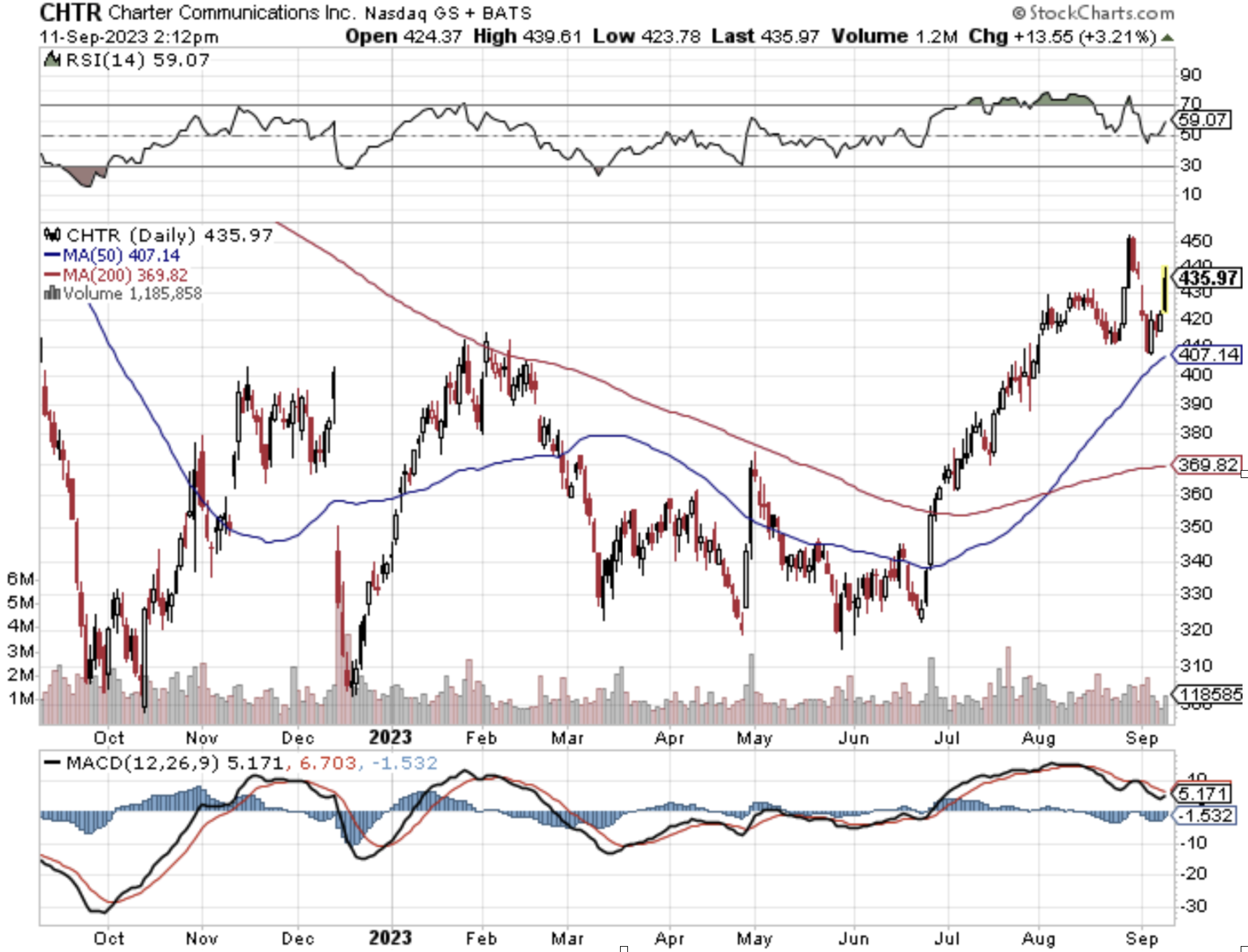
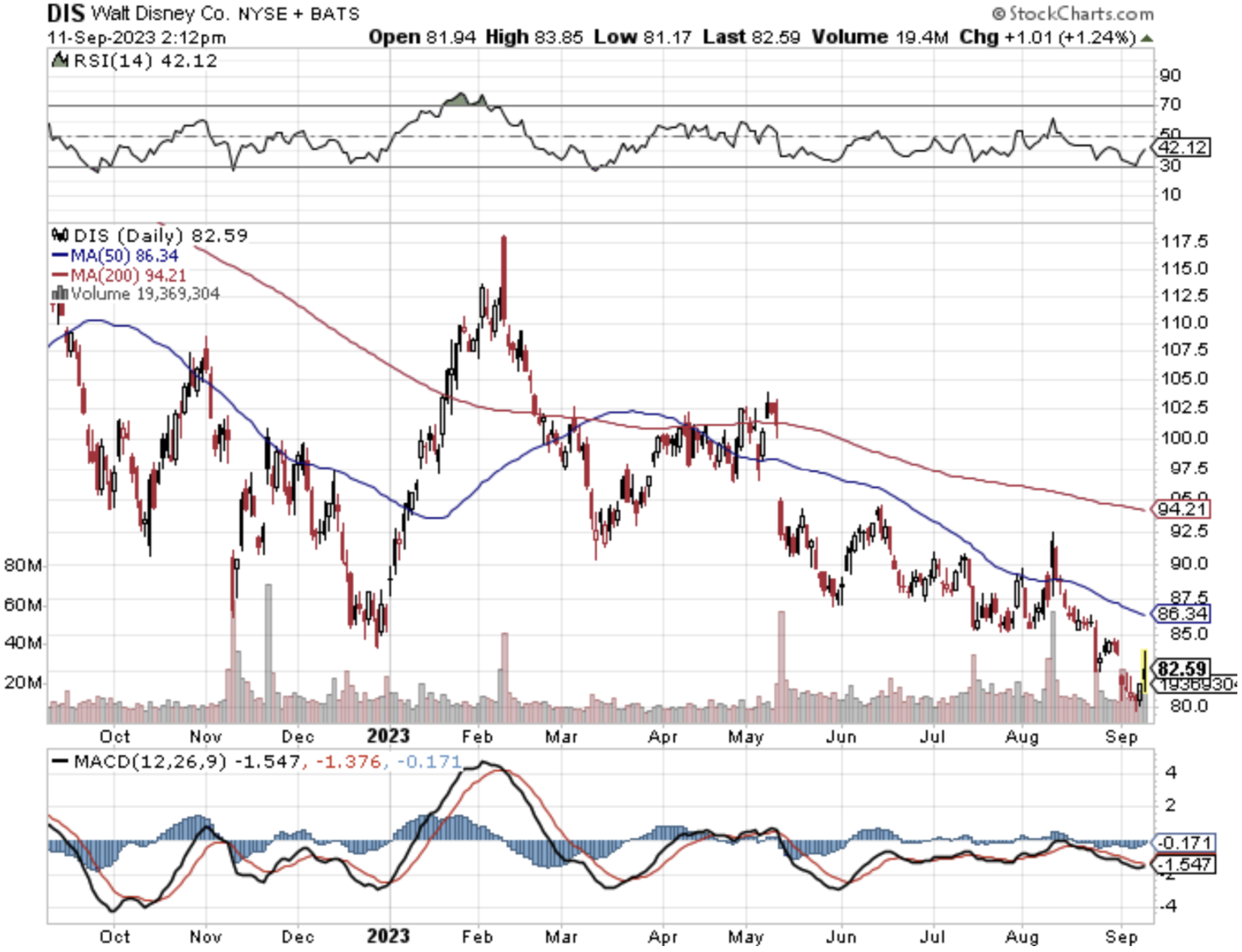
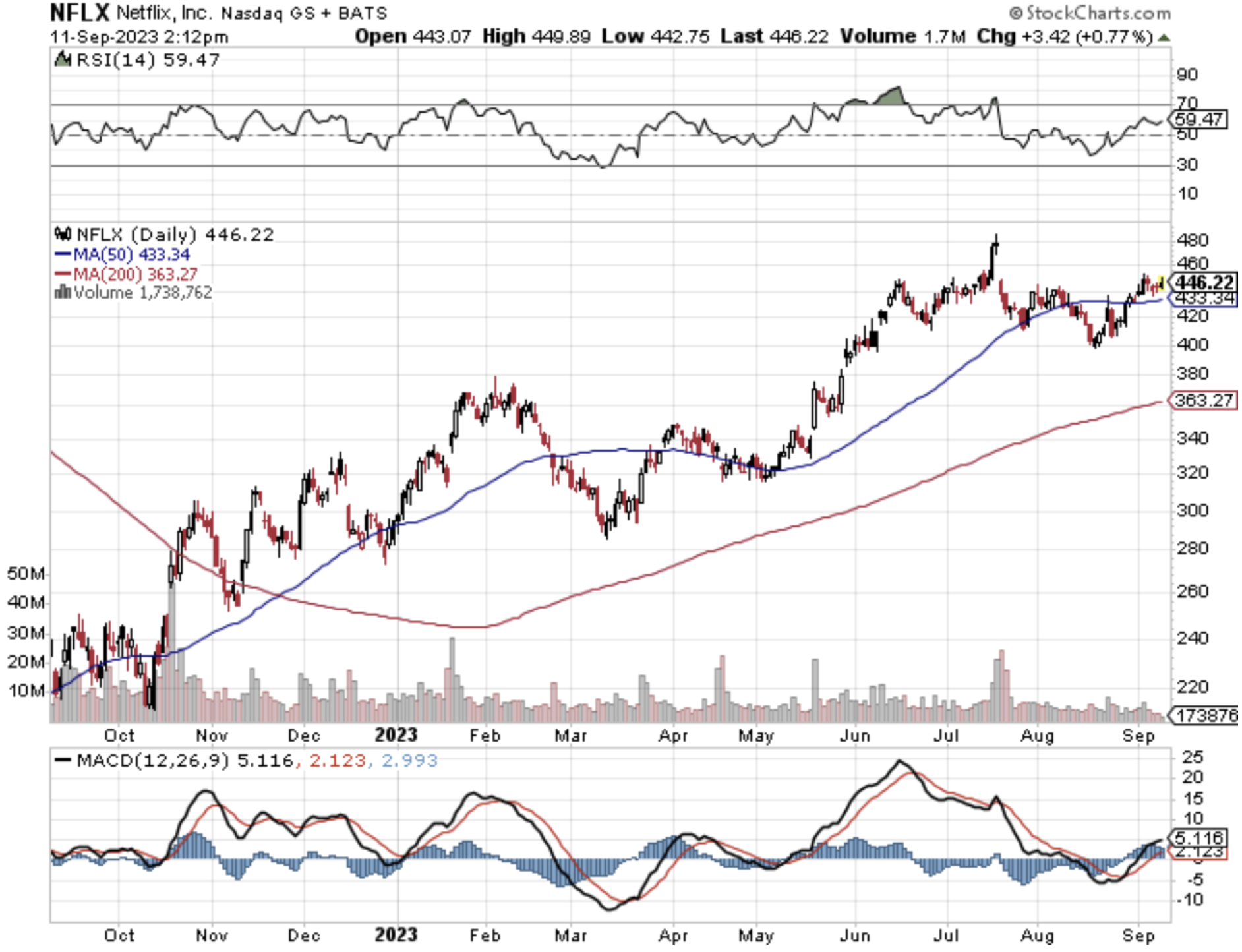
Global Market Comments
August 24, 2023
Fiat Lux
Featured Trades:
(AN INSIDER’S GUIDE TO THE NEXT DECADE OF TECH INVESTMENT),
(AMZN), (AAPL), (NFLX), (AMD), (INTC), (TSLA), (GOOG), (META)

CLICK HERE to download today's position sheet.
Mad Hedge Technology Letter
August 16, 2023
Fiat Lux
Featured Trade:
(CORD CUTTING IS TAKING OVER)
(NFLX), (GOOGL), (AMZN), (CMCSA), (DIS)

Cord-cutting is going into overdrive as linear TV viewership has just fallen below 50% nationally in July for the first time.
Big changes are about to happen.
This has major ramifications for not only the tech sector but for the broader economy, society, and geopolitics.
We are here to talk about the tech and the sinking of linear TV does mean relative gains for online streamers.
Broadcast and cable each hit a new low of 20% and 29.6% of total TV usage, respectively, to combine for a linear television total of 49.6%.
Has the quality of linear TV channels soured in quality or what is the deal?
It could be a functional reason, as Baby Boomers are watching linear tv because they haven’t figured out the streaming thing yet.
The ease of flipping on the tv with a remote cannot be understated.
In the future, the result is that linear tv penetration will be down to 20% level in around 20 years.
The players that will begin advancing further center stage into the national consciousness are YouTube (GOOGL), Netflix (NFLX), and Amazon Prime Video (AMZN).
They saw month-over-month viewership increases of 5.6%, 4.2%, and 5%, respectively, in July.
Don’t expect a rebound, because linear tv is bleeding viewers reflecting how bad TV channels have become.
Ad revenue across our media network coverage fell 13% on average in Q2, down from -8% in 1Q, which included the Super Bowl.
That being said, certain streamers haven’t exactly cracked the code either, as Peacock, Disney+, Hulu, ESPN+, Paramount+, Max and Discovery+ were down by about 500,000 combined.
However, on the whole, subscriber growth was 8.5% year-over-year with highlights like Netflix adding 5.9 million subscribers in the second quarter.
Comcast's Peacock (CMCSA) was able to grow its subscriber base 84% year-over-year to 24 million, up from the prior 13 million, as the streamer works to catch up to its peers amid a significant lag.
Direct-to-consumer advertising (DTC) grew 27% on average across media companies including Disney (DIS), Comcast, Warner Bros. Discovery (WBD), and Paramount (PARA). That's double from the 13% growth posted in the first quarter.
Comcast is the farthest behind, as only 14% of its estimated revenues are expected to come from DTC in 2024 with the other 85% stemming from its linear networks. Disney is the farthest along, with DTC revenue expected to surpass linear network revenue for the first time in 2024.
As linear tv is headed to the dustbin of history, streaming is also getting more expensive.
Personally, that is what I have seen as many platforms are starting to push the $100 plus per month level.
Many might remember when streaming was $20-$40 per month.
Therefore, I am not surprised to see single-digit growth for streaming as high prices crimps demand.
It’s true that mass media is fracturing into different niches and communities and that isn’t so fantastic for big media corporations as it could mean higher costs and a smaller total addressable audience.
I still do believe there is growth in streaming but not at the elevated levels like the 20% or 30% range.
Customer acquisition will also become more difficult and expensive as people really need to be convinced to move platforms or online channels.
The golden age of streaming growth is over and now each inch will be fought tooth and nail by more competition.
In the short term, I believe a dip in CMCSA should be bought, as they are still driving users to the Peacock platform. NFLX is still worth a trade on the dip as well, but I would avoid DIS until they structurally upgrade the company.
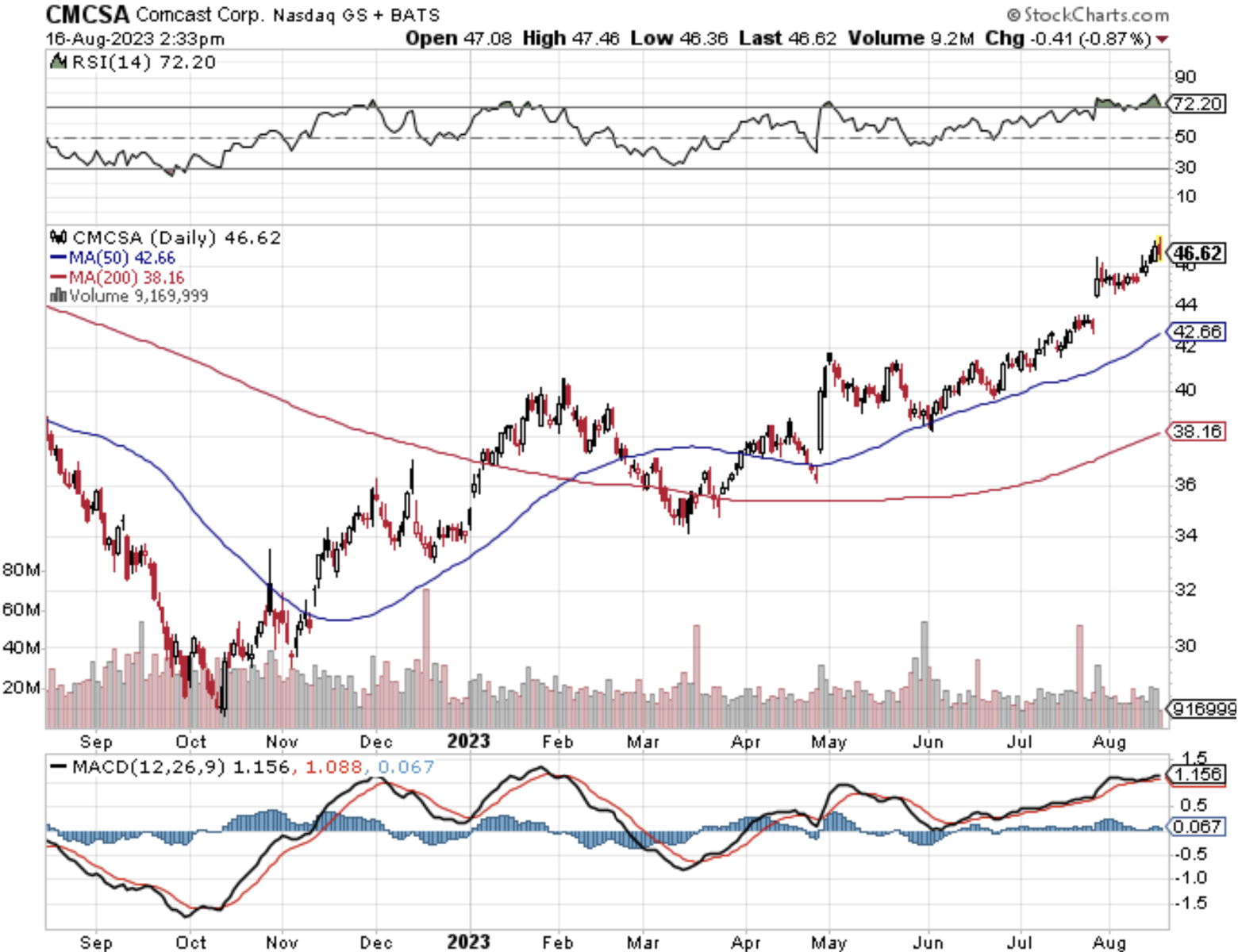
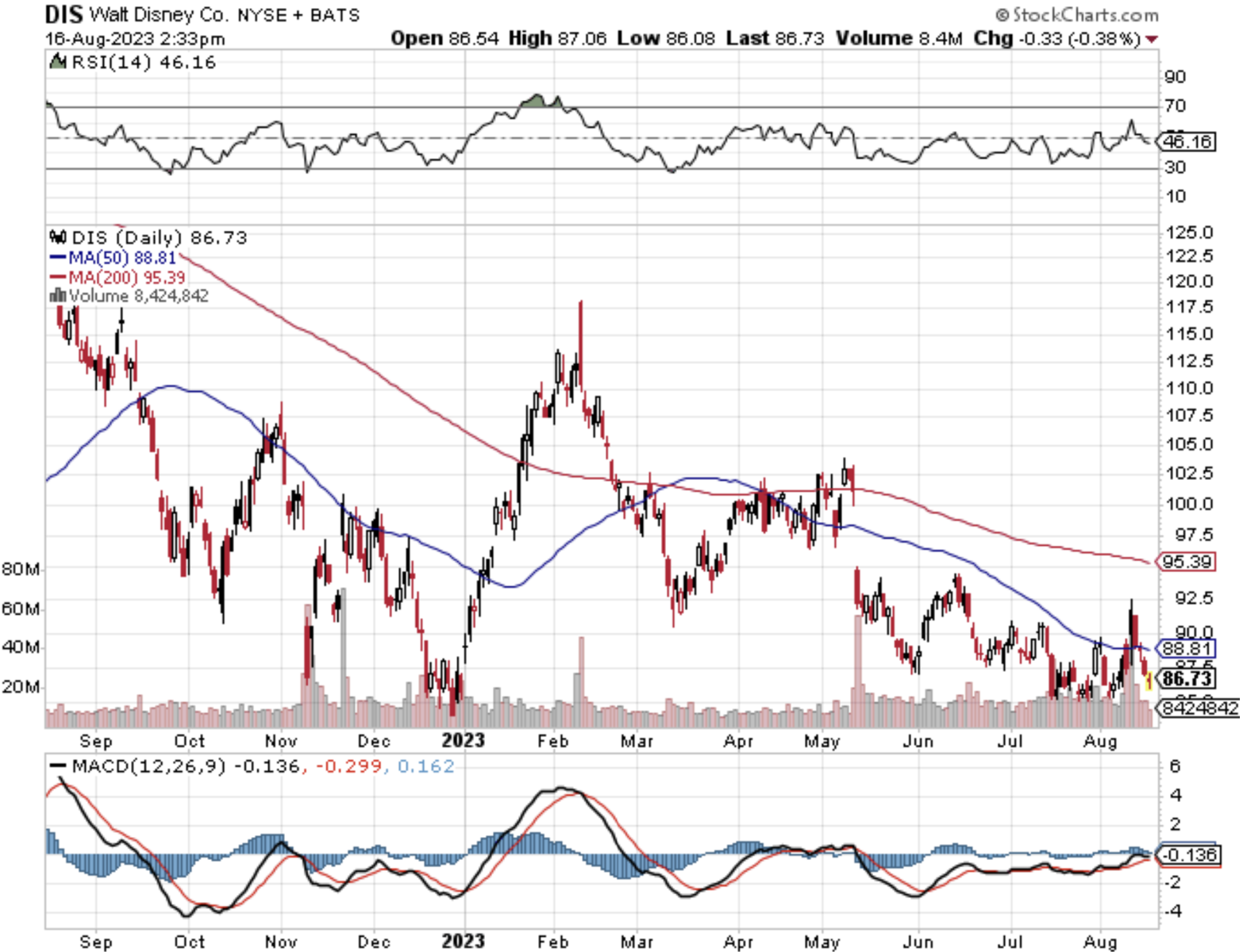

Mad Hedge Technology Letter
July 24, 2023
Fiat Lux
Featured Trade:
(REBALANCING BEFORE THE NEXT MOVE)
(NFLX), (QQQ)

In quite an unprecedented maneuver; the people who run the Nasdaq have chosen to water down the biggest tech components because a few companies are exerting too much power over the index.
In other words, the big fish have gotten so big that the index is adjusting their formula.
This speaks volumes about how great the top 7 tech stocks have performed in 2023.
They have taken off like a runaway train and haven’t looked back.
If this turns out to be a less-than-blockbuster earnings season and the market offers a pullback, it may be the last opportunity of the year to get into high quality tech stocks at a discount.
Selloffs from blue chip tech firms like Netflix (NFLX) signal that a short-term technical cooldown could be in the cards for tech stocks.
NFLX came back to earth, but I want to reiterate that it is more than healthy price action for this stock which started out the year at $300 per share.
The stock exploded to $480 per share and the post-earnings cooldown has found the stock in the $420 per share range.
There are a handful of blue chip tech stocks that I would regard this sort of price action as a mind-blowing opportunity.
Another reason for a short-term cooldown is the aforementioned reformulation of the Nasdaq index.
The tech-based index - Nasdaq 100 gets tracked by a slew of funds.
They include the Invesco QQQ Trust (QQQ), the world’s fifth-largest exchange-traded fund (ETF), according to Morningstar.
Nasdaq announced that the Nasdaq 100 index will undergo a "special rebalance" that will come into effect today.
The index is typically rebalanced each quarter, but outside of that, it can employ a special rebalance to address overconcentration in the index by redistributing the weights.
While the organizers have been mum on the technical about the rebalancing, the index's methodology says that it can be adjusted if companies with weightings that exceed 4.5% of the index together make up more than 48% of the index.
This technical maneuver underscores the attractiveness of these tech businesses and compelling investment opportunities relative to other areas.
The result has been increased investor attention and enthusiasm for tech stocks now — at the expense of other sectors, he says.
Investors of funds tracking the Nasdaq 100 Index woke up today with a different portfolio.
Most investors in U.S. stocks will be at least indirectly affected by the rebalance.
That's because "billions of dollars of stock" will be traded as funds tracking the Nasdaq 100 buy and sell in response to the rebalancing.
During this short-term rebalancing phase, I can easily visualize a convenient time for investors to reload their ammunition. Load up the bullets before we are off to the races again.
Heading into the last 4 months of the year, the US consumer is strong as steel and I would beg any black swan to show their ugly face and try to topple this kryptonite tech market.
An orderly dip in tech stocks this earnings season would represent nothing more than a massive victory and if it’s sideways then watch up to the upside.
I would even say there is a higher risk that dip buyers get a little impatient and pull the trigger a little early just to make sure they get some skin in the game for the next elevator up.
That’s how hot tech has been.
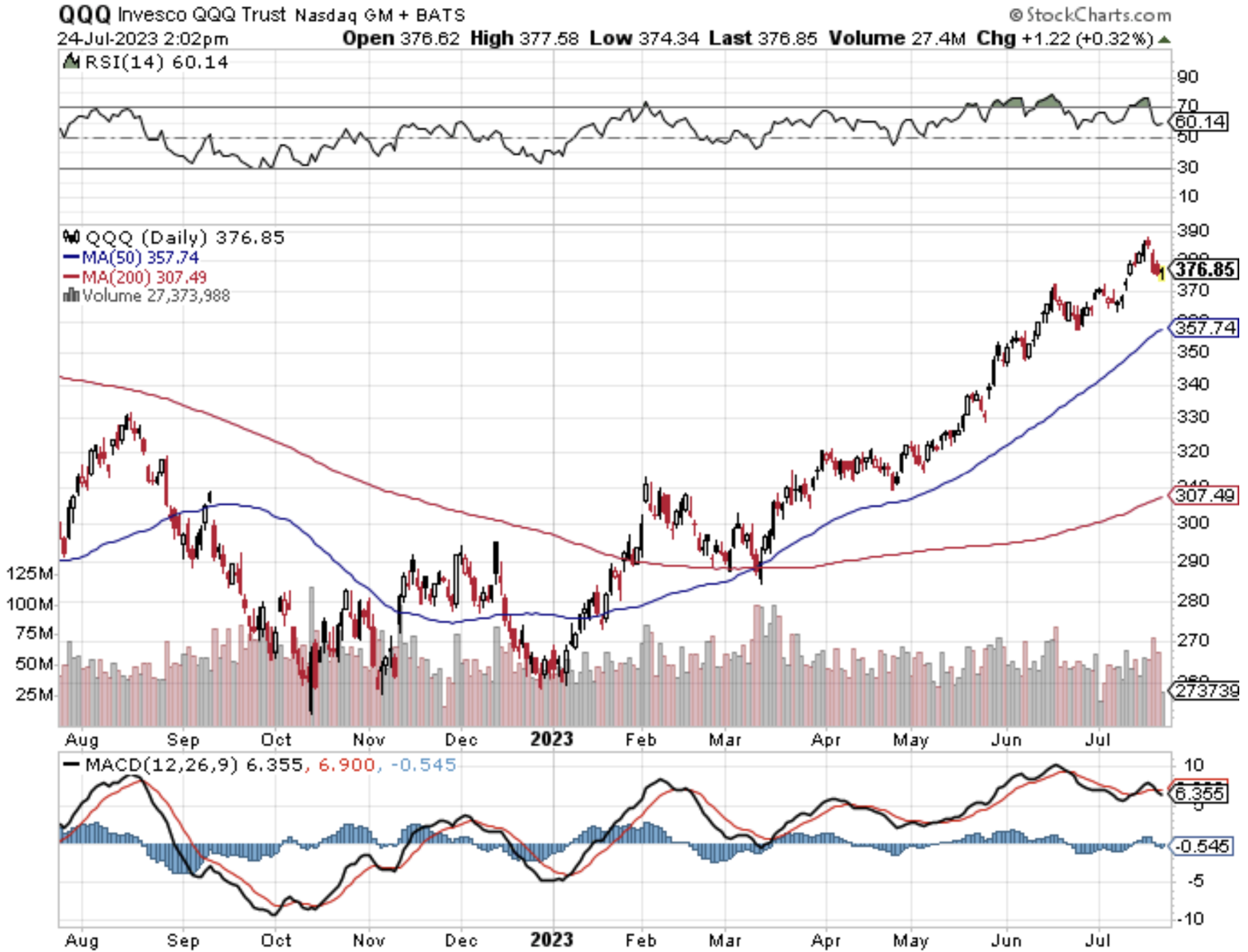
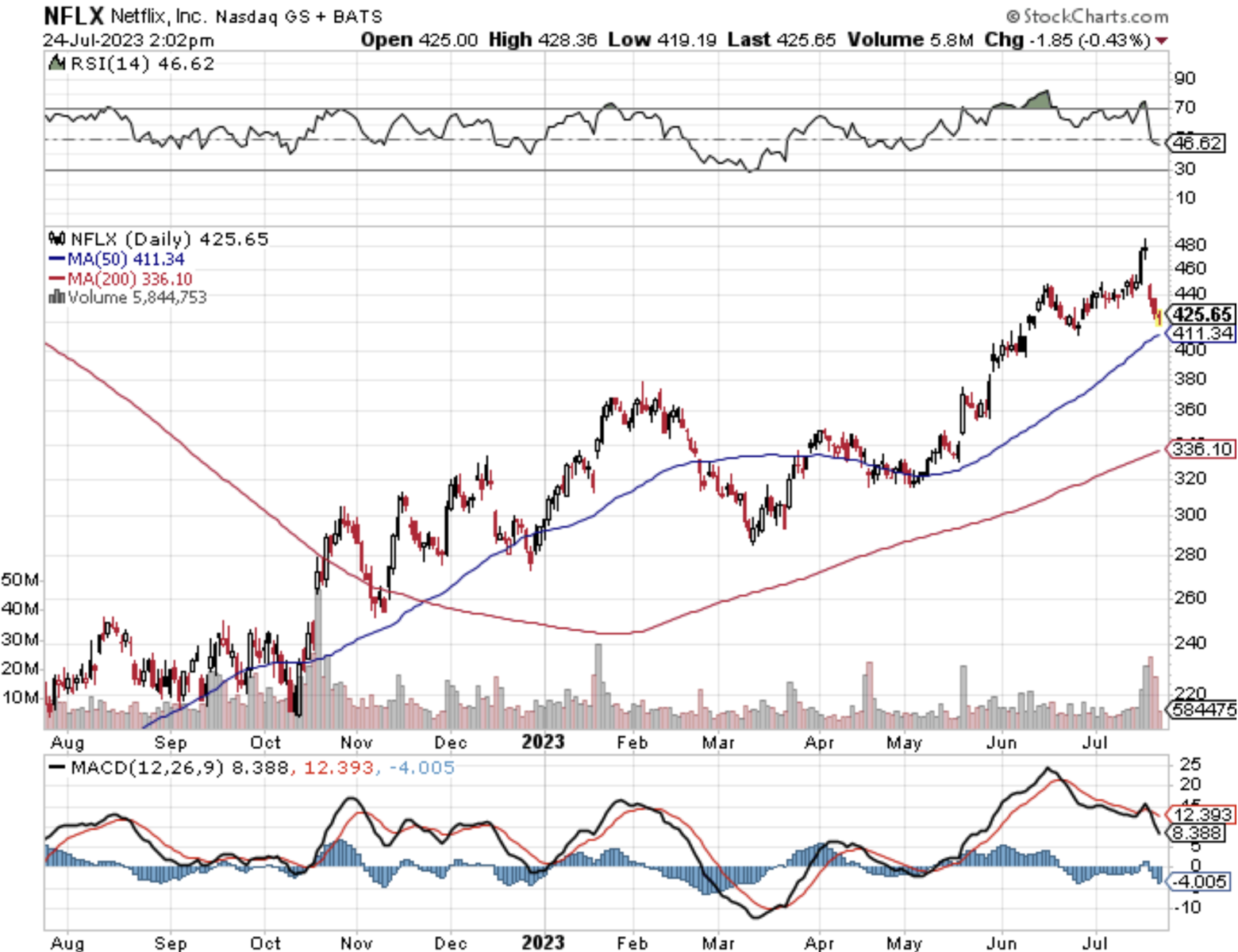
Mad Hedge Technology Letter
July 21, 2023
Fiat Lux
Featured Trade:
(WHAT TO DO ABOUT NETFLIX SHARES?)
(NFLX), (APPL), (MSFT)

It’s quite the irony that Netflix’s earnings report came smack dab in the middle of Hollywood’s meltdown as the contract standoff between writers and studios threaten to implode a Southern Californian industry that has been on life support for quite some time.
One’s famine is another’s fortune.
NFLX had a mixed earnings report so it’s not like it has been gangbusters for streaming platforms either.
They used to be a perennial tech growth company and now they are down to just 3% revenue growth which won’t cut it.
NFLX has been saved by the macro picture as traders scurried into tech stocks from early 2023 while investors bet on a Fed pivot and a reversion to the mean after a horrible 2022.
The business itself isn’t doing anything special like it used to, and they are also way too woke, but when they don’t have to be spectacular, it’s easier for the stock to elevate.
The brightest number of all was the addition of 5.9 million subs.
Netflix, which now boasts 238 million global subscribers, will keep benefiting from this password-sharing clampdown.
Some expected it to backfire, but viewers have flashed their wallets and signed up for the service.
The streamer boasted that “sign-ups are already exceeding cancellations” and that it is implementing the password policy across the world now.
Profitability is starting to become an issue for NFLX as they missed on revenue.
Streaming has become a worse business lately because the world is too saturated with content.
Another positive is that NFLX upped its free cash flow from $1.5 billion to approximately $5 billion for the year.
This is what mature tech companies are supposed to do.
Eventually, they will increase deliverables back to the shareholder in the form of buybacks and dividends like Apple (AAPL) and Microsoft (MSFT).
The company cited “lower cash content spend” amid the writers’ and actors’ strikes that have brought content production to an absolute standstill.
No more $9.99 ad-free plan.
Netflix axed its cheapest ad-free option in the US and the UK. The plan, offered at $9.99, is no longer available to new customers.
The decision to cut the skeleton plan appears aimed at pushing subscribers in that price tier toward the ad-supported model, which is priced at $6.99. The company has previously said the ad-supported model performed better on the “economics” than the $9.99 ad-free model.
NFLX shares have had a great year so far with shares up 44%.
The 44% upswing is also after an 8% drop yesterday on this earnings report.
Clearly, traders used this opportunity to take profits.
NFLX’s performance is part of my wider thesis that earnings won’t be anything special, but good enough to deliver a better entry point into these stocks.
Buy the dip strategy will perpetuate for most brand-name tech companies.
It’s not exactly simple to get into a stock that has gone up 44% in 7 months because most of the time the stock needs to be chased.
Chasing tech stocks is an underlying theme of 2023 with fear of missing out (FOMO) engulfing most fund manager’s plans of attack.
So yes, I do believe many investors will use these tepid earnings reports to take profits and these dips are incredibly healthy for the tech sector.
Thus, traders should reload because tech stocks like NFLX will be on discount before the next leg higher.
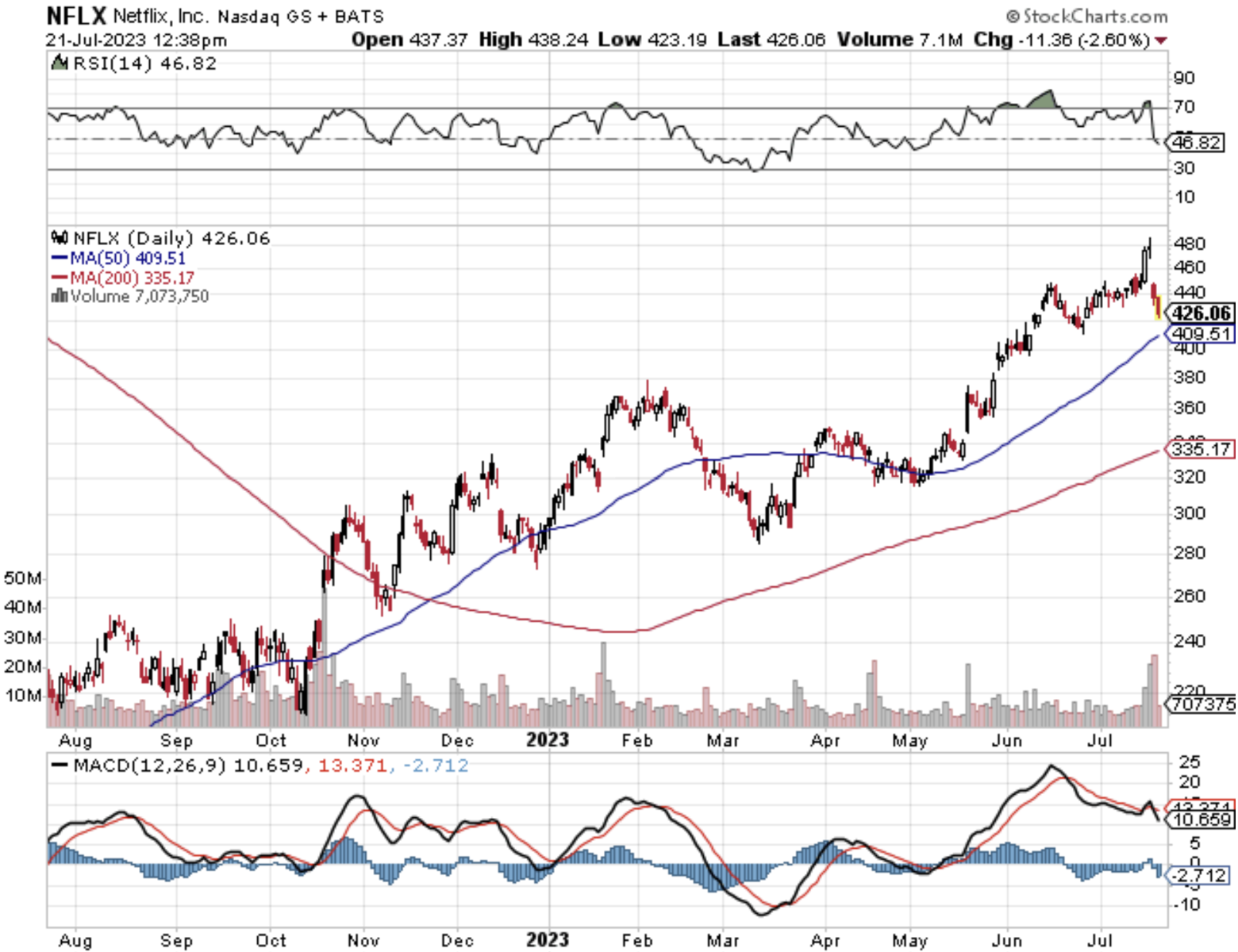
Global Market Comments
July 21, 2023
Fiat Lux
Featured Trades:
(WHAT THE NEXT RECESSION WILL LOOK LIKE),
(FB), (AAPL), (NFLX), (GOOGL), (KSS), (VIX), (MS), (GS),
(TESTIMONIAL)

CLICK HERE to download today's position sheet.
Legal Disclaimer
There is a very high degree of risk involved in trading. Past results are not indicative of future returns. MadHedgeFundTrader.com and all individuals affiliated with this site assume no responsibilities for your trading and investment results. The indicators, strategies, columns, articles and all other features are for educational purposes only and should not be construed as investment advice. Information for futures trading observations are obtained from sources believed to be reliable, but we do not warrant its completeness or accuracy, or warrant any results from the use of the information. Your use of the trading observations is entirely at your own risk and it is your sole responsibility to evaluate the accuracy, completeness and usefulness of the information. You must assess the risk of any trade with your broker and make your own independent decisions regarding any securities mentioned herein. Affiliates of MadHedgeFundTrader.com may have a position or effect transactions in the securities described herein (or options thereon) and/or otherwise employ trading strategies that may be consistent or inconsistent with the provided strategies.
This site uses cookies. By continuing to browse the site, you are agreeing to our use of cookies.
OKLearn moreWe may request cookies to be set on your device. We use cookies to let us know when you visit our websites, how you interact with us, to enrich your user experience, and to customize your relationship with our website.
Click on the different category headings to find out more. You can also change some of your preferences. Note that blocking some types of cookies may impact your experience on our websites and the services we are able to offer.
These cookies are strictly necessary to provide you with services available through our website and to use some of its features.
Because these cookies are strictly necessary to deliver the website, refuseing them will have impact how our site functions. You always can block or delete cookies by changing your browser settings and force blocking all cookies on this website. But this will always prompt you to accept/refuse cookies when revisiting our site.
We fully respect if you want to refuse cookies but to avoid asking you again and again kindly allow us to store a cookie for that. You are free to opt out any time or opt in for other cookies to get a better experience. If you refuse cookies we will remove all set cookies in our domain.
We provide you with a list of stored cookies on your computer in our domain so you can check what we stored. Due to security reasons we are not able to show or modify cookies from other domains. You can check these in your browser security settings.
These cookies collect information that is used either in aggregate form to help us understand how our website is being used or how effective our marketing campaigns are, or to help us customize our website and application for you in order to enhance your experience.
If you do not want that we track your visist to our site you can disable tracking in your browser here:
We also use different external services like Google Webfonts, Google Maps, and external Video providers. Since these providers may collect personal data like your IP address we allow you to block them here. Please be aware that this might heavily reduce the functionality and appearance of our site. Changes will take effect once you reload the page.
Google Webfont Settings:
Google Map Settings:
Vimeo and Youtube video embeds:
